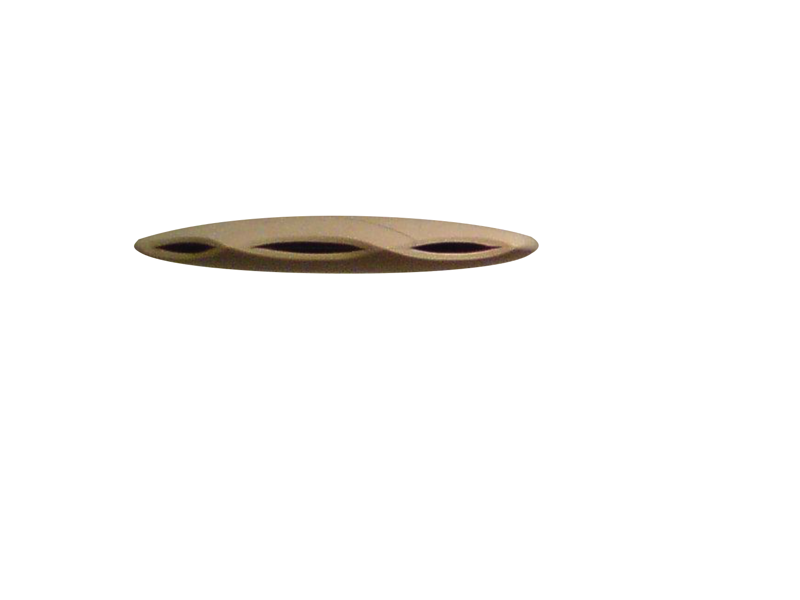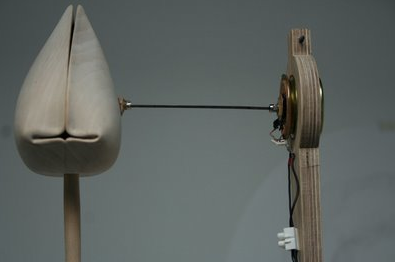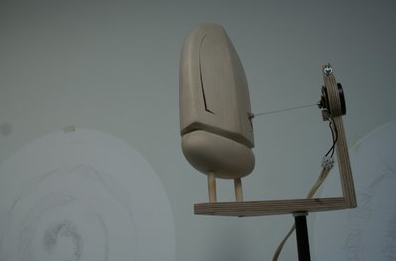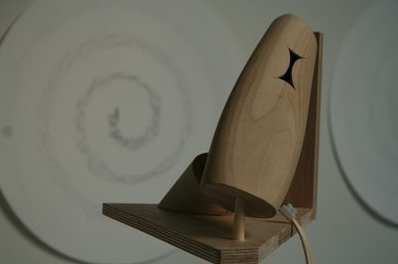The 21st Century Violin Project
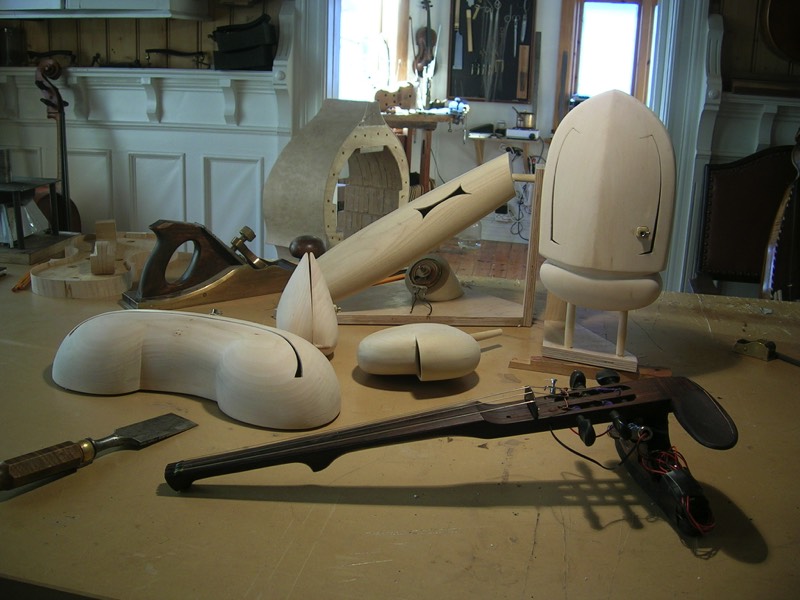
Interview with Hans Johannsson by Alice Rawsthorn for the International Herald Tribune.
1. How did the project come about, and what made you decide to develop a new type of stringed instrument?
This is an idea that I have had for many years, but in the summer of 2005, Olafur Elíasson and I had a chat about vibrations, waves and similar time domain phenomena, and their cognitive potential for placing the individual in a relation to the environment. A couple of weeks later I realised that Olafur was about to embark on some sort of work with sound oriented installations, so I suggested that we collaborate on designing a stringed instrument that was entirely based on 21st century technology and artistic/aesthetic sensibility. Fortunately he was very enthusiastic and we continued throwing ideas back and forth about the nature of sound and we had some inspiring philosophical and speculative talks. I have been making traditional violins,violas,cello´s and double basses for over twenty years, but I had always been perplexed by the idea that the violin family instruments had been locked in an evolutionary vacuum. I had for years been dreaming of making instruments that looked more like an Arne Jacobsen chair or a Bang and Olufssen stereo. Eventually Olafur invited me to his studio in Berlin where the atmosphere is electric. It is a bit like a renaissance dream, where Olafur´s team of skilled individuals, each a specialist in some field, would sit around a big table at lunchtime and have heated discussions about art, architecture technology etc. The great violin making masters of the seventeenth and eighteenth centuries were living in a time when different disciplines like mathematics, astrology,music,philosophy were fused into a seething conglomerate of activity. Somehow I feel as if today is also characterised by a similar situation. After lengthy discussions we decided to have a go at designing a truly contemporary instrument that was nonetheless solidly anchored in string playing traditions and culture of sound.
2. What's wrong with existing instruments like violins and cellos?
Nothing, apart from a few practical drawbacks like the infamous "wolftone", which is a vibratory phenomena which can be annoying or obtrusive.
The classical instruments are highly revered by players and makers alike. That should not prevent us from indulging in the natural curiosity and desire to tread new ground. If we continue to emulate the form designed in the renaissance blindly, we won´t make any sort of aesthetic progress. we will be stuck in a reinactment game . In fact the reason for the stagnation in instrument making for a long time after the classical period, I think can be rooted in a certain lack of confidence and a rather unnecessary idolation of an archaic ideal. I can imagine a standard critique on this idea would be on the lines of "Why not first try to equal the quality of the great masters, before embarking on the road to invention or improvement". The debate about the superiority of classical instruments over contemporary works is rather misleading for various reasons and I think that one of the reasons for the lesser status of violins,violas and cello´s produced in modernity has partly to do with lack of confidence and a negative reverence for the supremacy of the old.
3. How will the new instrument be different from traditional ones in terms of the design process, materials, production, shape etc?
The design process of the seventeenth century instruments was probably based on the basic building blocks of renaissance constructional thought ,i.e. the compass and rule, using the concepts of euclidean geometry and pythagorean principles of proportion,harmony and order.
Of course we are still using some of these ancient methods today. The LEM module would not have landed on the moon without the idea of the hypotenuse triangle. What possibly unites the methods of today with those of the baroque is the notion of proportion and harmony having something intrinsically to do with beauty although this is a matter of debate. The use of numerical proportion is very deeply rooted in art and architecture. The elaborate digital algorithms that create three dimensional shapes and forms in todays high tech design environment however are not physically bound by the compass and rule and open up endless possibilities of execution. Also we have at our disposal, a number of new synthetic materials that have only been available recently. It will be our job to correlate those possibilities with vibratory behaviour and sound production.
As this is a cross disciplinary endeavour, we want to fuse the technology of today and modern architectural and artistic ideologies with the tacit empirical traditions of violin making. That is why the first prototypes were made in wood as intuitively sculpted forms based on natural phenomenae.
At the onset of the project we joked about making a sophisticated rendition of an acoustic instrument even if it ended up looking like a cockroach.
If italian masters of the seventeenth century were with us now, I am sure they would be exploring every material and technology that is on offer now.
4. What sort of music will be played on it? How will it differ from existing music for strings?
One of the things that I emphasised from the start was my conviction that the creation of a new culture surrounding the new instrument was not a prerequisite. On the contrary it should cater to the development of existing contemporary stringed instrument musical idioms. After all the string playing tradition is not stagnant. Modern music has been played all along on traditional instruments. Bartok and Ravel were not played on Art nouveau violins in their time. (why not?) We could just as well play Buxtehude on the new instrument, unless we wanted to recreate some timbre belonging exclusively to "period" instruments. Contemporary music is played on 18th century instruments today, and the new instrument will equally be able to play ancient music.
5. What are your thoughts on the Sound Experiment, and the playing of the lo-fi prototype at the Serpentine Gallery?
The experiment was a success, in that it demonstrated that a multi resonator approach without the use of loudspeakers, is quite plausible and effectively paves the way for phase two of the project. It was surprising how violin -like the sound was and how non-electric the violin sounded. Because these were hand carved resonator sculptures, made more from gut feeling than technical predictions, there were bandwidths that didn´t fit exactly with the idealised frequency responses that culture has dictated as a desireable violin sound. By carving these arbitrarily shaped boxes by hand, and consequently measuring their vibrational behaviour however, we learned a great deal about the relation of shape and size to how they propagate sound.
Also the crudeness of the setup, which in some ways was fun, meant that there were cracks and pops heard that weren´t supposed to be there and we had to restrict ourselves to a fairly low level, and Thomas Gould did a great job of improvising,despite these restrictions. Having said that, I think the audience appreciated the subtle aspect of the demonstration.
In the work ahead, we will be relying much more on sophisticated techniques such as structural modal analysis and finite element modeling, although maintaining a healthy connection to violin making.
6. What changes are you likely to make to the prototype as a result of that experiment?
Well phase two should see a sophisticated version of the serpentine prototype, where the modules will be more accurately tuned and, we will have made decisions on which materials to use and where the shapes will be more or less computer generated. At this stage the separate modules will present other possibilities for sound installation and open avenues for exploring spatial sound art.
The next stage, really will be to determine the number of neccessary resonators and their tuning.
7. How do you and your collaborators plan to continue the development of the new string instrument in future?
I think that despite the fact that we are interacting in a mutually beneficial way as artist/architect/engineer/instrument maker,we all have our own personal goals in a way also. Andreas might be more interested in the way structures oscillate, and behave in relation to their physical gestalt. Olafur might be preoccupied with the way in which waves ,vibrations and reverberations of objects and the spaces in which they are presented affect our basic spacetime experience and understanding, and my goal is to make a great sounding new instrument, based on contemporary notions of aesthetics and functionality using replenishable high and low tech materials. We are feeding each others needs.
I also think that it is imperative that to be in keeping with the present, we should strive to abandon the classification of these different disciplines into separate entities, and try to see them as completely complementary pursuits.
The 3d stage will be to:
1.get rid of the electromechanical coupling and devise a new way to mediate energy from the vibrating string to the sounding corpus. (Separate electromechanical resonators will nonetheless be pursued independently).
2. Incorporate the modular elements once again into a unified body. As well as being more sensual for the player (actually feeling the object vibrate in your hands) it becomes a pars pro toto of itself, aesthetically as in a conventional instrument. You might argue that it is going round in a circle and becoming a violin/cello again, but we think it will be transmutated into a phenomenon,based on tradition that none the less reflects contemporary trains of thought. The end result will be a self sustained mechanical violin,viola,cello,bass.
1. How did the project come about, and what made you decide to develop a new type of stringed instrument?
This is an idea that I have had for many years, but in the summer of 2005, Olafur Elíasson and I had a chat about vibrations, waves and similar time domain phenomena, and their cognitive potential for placing the individual in a relation to the environment. A couple of weeks later I realised that Olafur was about to embark on some sort of work with sound oriented installations, so I suggested that we collaborate on designing a stringed instrument that was entirely based on 21st century technology and artistic/aesthetic sensibility. Fortunately he was very enthusiastic and we continued throwing ideas back and forth about the nature of sound and we had some inspiring philosophical and speculative talks. I have been making traditional violins,violas,cello´s and double basses for over twenty years, but I had always been perplexed by the idea that the violin family instruments had been locked in an evolutionary vacuum. I had for years been dreaming of making instruments that looked more like an Arne Jacobsen chair or a Bang and Olufssen stereo. Eventually Olafur invited me to his studio in Berlin where the atmosphere is electric. It is a bit like a renaissance dream, where Olafur´s team of skilled individuals, each a specialist in some field, would sit around a big table at lunchtime and have heated discussions about art, architecture technology etc. The great violin making masters of the seventeenth and eighteenth centuries were living in a time when different disciplines like mathematics, astrology,music,philosophy were fused into a seething conglomerate of activity. Somehow I feel as if today is also characterised by a similar situation. After lengthy discussions we decided to have a go at designing a truly contemporary instrument that was nonetheless solidly anchored in string playing traditions and culture of sound.
2. What's wrong with existing instruments like violins and cellos?
Nothing, apart from a few practical drawbacks like the infamous "wolftone", which is a vibratory phenomena which can be annoying or obtrusive.
The classical instruments are highly revered by players and makers alike. That should not prevent us from indulging in the natural curiosity and desire to tread new ground. If we continue to emulate the form designed in the renaissance blindly, we won´t make any sort of aesthetic progress. we will be stuck in a reinactment game . In fact the reason for the stagnation in instrument making for a long time after the classical period, I think can be rooted in a certain lack of confidence and a rather unnecessary idolation of an archaic ideal. I can imagine a standard critique on this idea would be on the lines of "Why not first try to equal the quality of the great masters, before embarking on the road to invention or improvement". The debate about the superiority of classical instruments over contemporary works is rather misleading for various reasons and I think that one of the reasons for the lesser status of violins,violas and cello´s produced in modernity has partly to do with lack of confidence and a negative reverence for the supremacy of the old.
3. How will the new instrument be different from traditional ones in terms of the design process, materials, production, shape etc?
The design process of the seventeenth century instruments was probably based on the basic building blocks of renaissance constructional thought ,i.e. the compass and rule, using the concepts of euclidean geometry and pythagorean principles of proportion,harmony and order.
Of course we are still using some of these ancient methods today. The LEM module would not have landed on the moon without the idea of the hypotenuse triangle. What possibly unites the methods of today with those of the baroque is the notion of proportion and harmony having something intrinsically to do with beauty although this is a matter of debate. The use of numerical proportion is very deeply rooted in art and architecture. The elaborate digital algorithms that create three dimensional shapes and forms in todays high tech design environment however are not physically bound by the compass and rule and open up endless possibilities of execution. Also we have at our disposal, a number of new synthetic materials that have only been available recently. It will be our job to correlate those possibilities with vibratory behaviour and sound production.
As this is a cross disciplinary endeavour, we want to fuse the technology of today and modern architectural and artistic ideologies with the tacit empirical traditions of violin making. That is why the first prototypes were made in wood as intuitively sculpted forms based on natural phenomenae.
At the onset of the project we joked about making a sophisticated rendition of an acoustic instrument even if it ended up looking like a cockroach.
If italian masters of the seventeenth century were with us now, I am sure they would be exploring every material and technology that is on offer now.
4. What sort of music will be played on it? How will it differ from existing music for strings?
One of the things that I emphasised from the start was my conviction that the creation of a new culture surrounding the new instrument was not a prerequisite. On the contrary it should cater to the development of existing contemporary stringed instrument musical idioms. After all the string playing tradition is not stagnant. Modern music has been played all along on traditional instruments. Bartok and Ravel were not played on Art nouveau violins in their time. (why not?) We could just as well play Buxtehude on the new instrument, unless we wanted to recreate some timbre belonging exclusively to "period" instruments. Contemporary music is played on 18th century instruments today, and the new instrument will equally be able to play ancient music.
5. What are your thoughts on the Sound Experiment, and the playing of the lo-fi prototype at the Serpentine Gallery?
The experiment was a success, in that it demonstrated that a multi resonator approach without the use of loudspeakers, is quite plausible and effectively paves the way for phase two of the project. It was surprising how violin -like the sound was and how non-electric the violin sounded. Because these were hand carved resonator sculptures, made more from gut feeling than technical predictions, there were bandwidths that didn´t fit exactly with the idealised frequency responses that culture has dictated as a desireable violin sound. By carving these arbitrarily shaped boxes by hand, and consequently measuring their vibrational behaviour however, we learned a great deal about the relation of shape and size to how they propagate sound.
Also the crudeness of the setup, which in some ways was fun, meant that there were cracks and pops heard that weren´t supposed to be there and we had to restrict ourselves to a fairly low level, and Thomas Gould did a great job of improvising,despite these restrictions. Having said that, I think the audience appreciated the subtle aspect of the demonstration.
In the work ahead, we will be relying much more on sophisticated techniques such as structural modal analysis and finite element modeling, although maintaining a healthy connection to violin making.
6. What changes are you likely to make to the prototype as a result of that experiment?
Well phase two should see a sophisticated version of the serpentine prototype, where the modules will be more accurately tuned and, we will have made decisions on which materials to use and where the shapes will be more or less computer generated. At this stage the separate modules will present other possibilities for sound installation and open avenues for exploring spatial sound art.
The next stage, really will be to determine the number of neccessary resonators and their tuning.
7. How do you and your collaborators plan to continue the development of the new string instrument in future?
I think that despite the fact that we are interacting in a mutually beneficial way as artist/architect/engineer/instrument maker,we all have our own personal goals in a way also. Andreas might be more interested in the way structures oscillate, and behave in relation to their physical gestalt. Olafur might be preoccupied with the way in which waves ,vibrations and reverberations of objects and the spaces in which they are presented affect our basic spacetime experience and understanding, and my goal is to make a great sounding new instrument, based on contemporary notions of aesthetics and functionality using replenishable high and low tech materials. We are feeding each others needs.
I also think that it is imperative that to be in keeping with the present, we should strive to abandon the classification of these different disciplines into separate entities, and try to see them as completely complementary pursuits.
The 3d stage will be to:
1.get rid of the electromechanical coupling and devise a new way to mediate energy from the vibrating string to the sounding corpus. (Separate electromechanical resonators will nonetheless be pursued independently).
2. Incorporate the modular elements once again into a unified body. As well as being more sensual for the player (actually feeling the object vibrate in your hands) it becomes a pars pro toto of itself, aesthetically as in a conventional instrument. You might argue that it is going round in a circle and becoming a violin/cello again, but we think it will be transmutated into a phenomenon,based on tradition that none the less reflects contemporary trains of thought. The end result will be a self sustained mechanical violin,viola,cello,bass.
